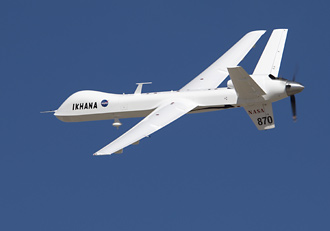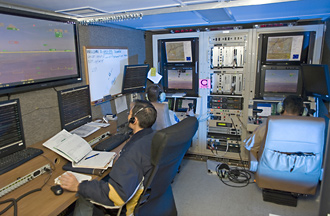- NASA Home
- | Centers
- | Dryden Home
- | News
- | Fact Sheets
Search Dryden
Fact Sheets
Ikhana Unmanned Science and Research Aircraft System
08.15.07
 Image above: Its white surfaces in contrast with the deep blue sky, NASA's Ikhana unmanned science and technology development aircraft soars over California's high desert. NASA photo by Tony Landis
Image above: Its white surfaces in contrast with the deep blue sky, NASA's Ikhana unmanned science and technology development aircraft soars over California's high desert. NASA photo by Tony Landis
Ikhana is a Native American Choctaw word meaning intelligence, conscious or aware. The name is descriptive of the research goals NASA has established for the aircraft and its re-lated systems.
Representative Experiments and Projects
The aircraft, designed for long-endurance, high-altitude flight, has been modified and instrumented for use in multiple civil research roles.
NASA's Suborbital Science Program within the Science Mission Directorate is Ikhana's primary customer, using the aircraft for Earth science studies. A variety of atmospheric and remote sensing instruments, including duplicates of those sensors on orbiting satellites, can be installed to collect data during flights lasting up to 30 hours. The Suborbital Science Program uses both manned and unmanned aircraft to collect data within the Earth's at-mosphere, complementing measurements of the same phenomenon taken from space and those taken on the Earth's surface.
NASA's Aeronautics Research Mission Directorate will also use the aircraft for advanced aircraft systems research and technology development. Initial experiments will look into the use of fiber optics for wing shape sensing and control and structural loads measurements.
 Image above: NASA's Ikhana unmanned science aircraft ground control station includes consoles for two pilots and positions for scientists and engineers along the side. NASA photo by Tony Landis
Image above: NASA's Ikhana unmanned science aircraft ground control station includes consoles for two pilots and positions for scientists and engineers along the side. NASA photo by Tony Landis
NASA has also purchased a ground control station and satellite communication system for uplinking flight commands and downlinking aircraft and mission data. The ground control station is installed in a mobile trailer and, in addition to the pilot's remote "cockpit," includes computer workstations for scientists and engineers. All the aircraft systems are mobile, making Ikhana ideal for missions conducted from remote sites around the globe.
Aircraft Description
General Atomics Aeronautical Systems Inc. (GA-ASI) of San Diego, Calif., developed the original Predator A medium-altitude, long-endurance UAS during the mid-1990s as an Advanced Concept Technology Demonstrator for the United States Air Force. Development of the larger, more powerful Predator B was initiated in 2000 by the firm with partial funding from NASA, which was interested in the Earth science capabilities of a civil version of the aircraft with a larger payload and high-altitude capability along with long endurance.
NASA's Ikhana / Predator B has a wingspan of 66 feet and is 36 feet long. More than 400 pounds of sensors can be carried internally and over 2,000 pounds in external under-wing pods. Ikhana is powered by a Honeywell TPE 331-10T turbine engine and is capable of reaching altitudes above 40,000 feet. The Ikhana is the first production Predator B equipped with a digital electronic engine controller developed by Honeywell and GA-ASI that will make Ikhana five to 10 percent more fuel efficient than earlier versions of the aircraft.